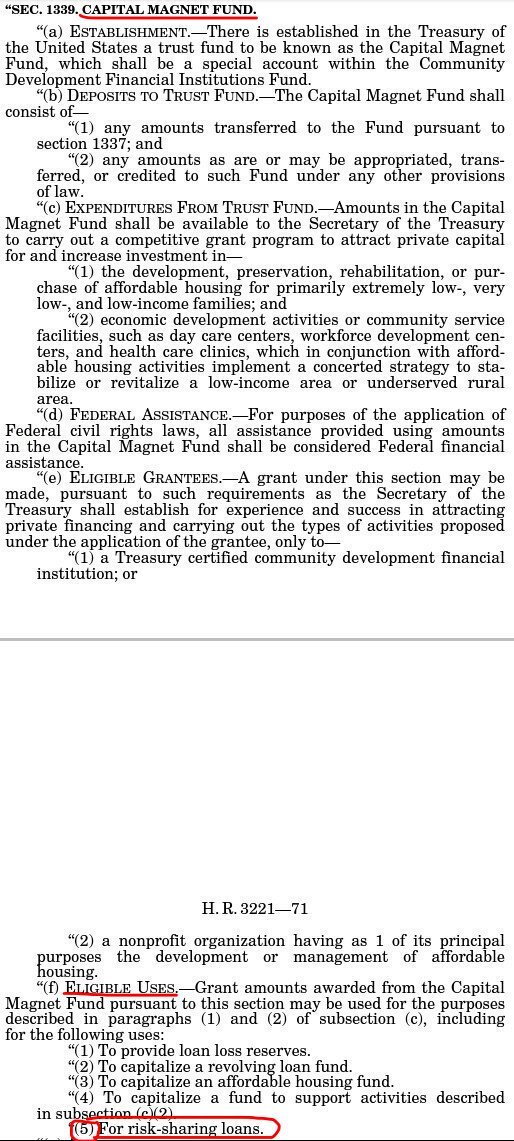Thursday, February 08, 2024 3:19:54 AM
It's not a question whether they are high or low or whether they make economic sense. They are huge by the way, as they represent 10 bps guarantee fee income out of 60 bps, and no sense during the Transition Period to build capital and with the Stress Tests.
They are illegal in the Charter Act, in the Credit Enhancement clause.
The authority of the conservator isn't to create a shadow Housing Finance System, in parallel to the one currently in force, Charter Act, that is being violated as a result, even if it's "in the best interests of the FHFA". The FHFA must uphold the law and the accounting principles.
HERA didn't turn the FHFA into an outlaw Federal Agency, as the hedge fund managers stuck to Fanniegate made us believe.
If it's money funneled to UST, then barred in the Fee Limitation clause too.
This is the most likely scenario, due to the slogan of Mnuchin "the taxpayer be adequately compensated", which can only occur in a different Charter.
A slogan repeated by the other Goldman Sachs alumni, Sandra Thompson, in her nomination hearing in the Senate. Coincidence?
Also, Sandra Thompson can't claim that it "protects the taxpayer" because the UST doesn't bear credit risk in FnF, nor "the SPS are taxpayer's losses" (UBS's Hensarling's remark, former financial committee chairman) but obligations issued by FnF. Primarily because the securities "to (iii) protect the taxpayer" (one of the 3 prerequisites on the purchase in the UST's authority) had a deadline on the purchase of December 31, 2009. Let alone that FnF sell the securities STACR and CAS, the don't buy securities.
You may say that, this is precisely why the deadline doesn't apply. Then, back to square one with the securities barred in the Credit Enhancement clause.

Called "responsible innovation" by Mel Watt (Source), a tell-tale sign of a scam. Notice that the unbacked token bitcoin, was called safe innovation by lawmakers, a sign that they are always instructed by bigger players.
Likewise, it isn't a coincidence that the CRT were promoted through annual CRT Symposiums attended by Blackrock and the former UST counselor, Craig Phillips, in turn, former BLK and MS (sued by the FHFA for the sale of fraudulent PLMBSs to FnF), and soon after, the Bitcoin symposiums began to run.
HERA didn't authorize CRTs with FnF in either of its patches inserted in the FHEFSSA or in the Charter Act. It only authorized the UST to do CRTs with its portion (35% to the Capital Magnet Fund) of the funds that FnF allocate to two Affordable Housing Trusts managed by the UST and HUD (4.2 bps on new acquisitions in total)

The amount of CRT expenses, net (turned into Retained Earnings, which is how FnF are protected against future losses. Currently an adjusted $-216B Accumulated Deficit Retained Earnings accounts. What the Capital ratios are for) requested as refund, stands at $18B as of September 30, 2023 ($9B each)
Avant Technologies Engages Wired4Tech to Evaluate the Performance of Next Generation AI Server Technology • AVAI • May 23, 2024 8:00 AM
Branded Legacy, Inc. Unveils Collaboration with Celebrity Tattoo Artist Kat Tat for New Tattoo Aftercare Product • BLEG • May 22, 2024 8:30 AM
"Defo's Morning Briefing" Set to Debut for "GreenliteTV" • GRNL • May 21, 2024 2:28 PM
North Bay Resources Announces 50/50 JV at Fran Gold Project, British Columbia; Initiates NI 43-101 Resources Estimate and Bulk Sample • NBRI • May 21, 2024 9:07 AM
Greenlite Ventures Inks Deal to Acquire No Limit Technology • GRNL • May 17, 2024 3:00 PM
Music Licensing, Inc. (OTC: SONG) Subsidiary Pro Music Rights Secures Final Judgment of $114,081.30 USD, Demonstrating Strength of Licensing Agreements • SONGD • May 17, 2024 11:00 AM










